



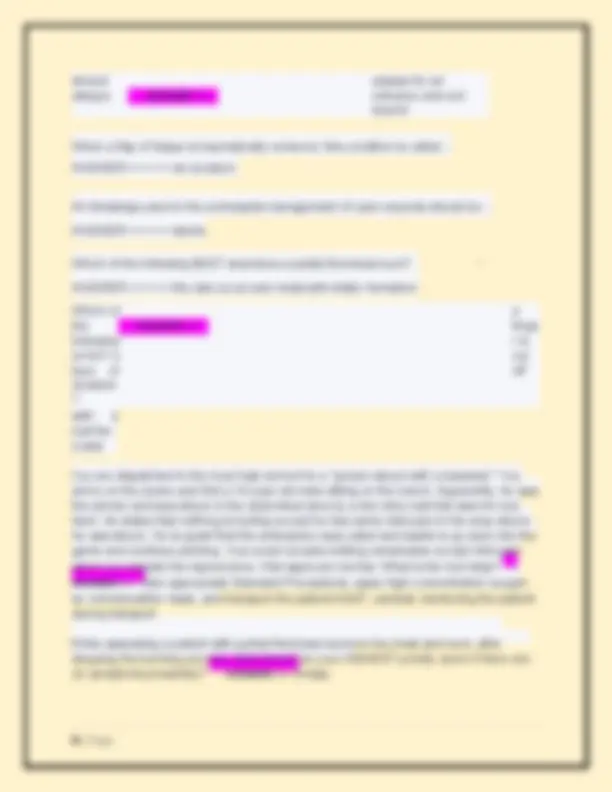

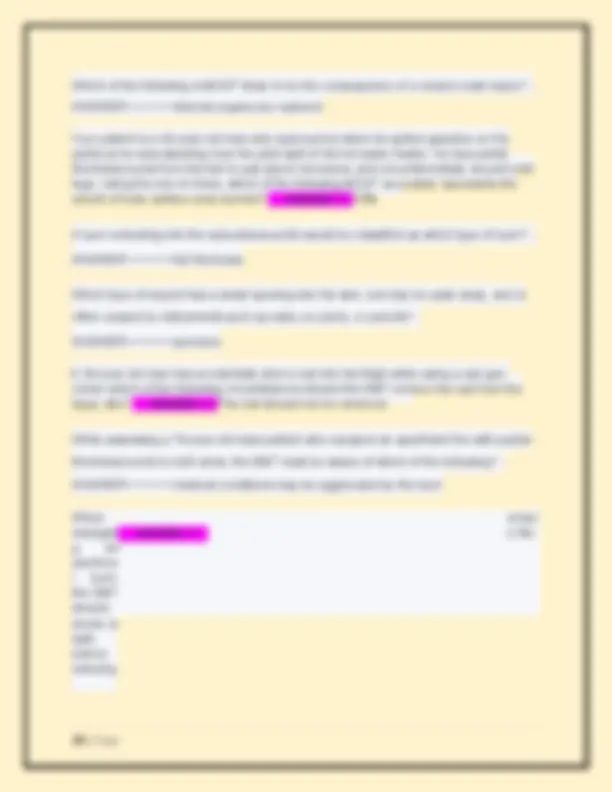


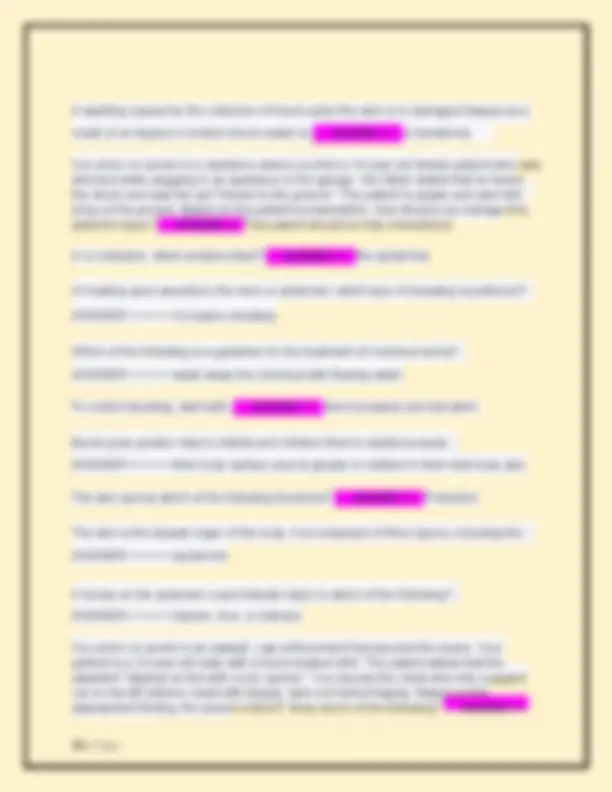



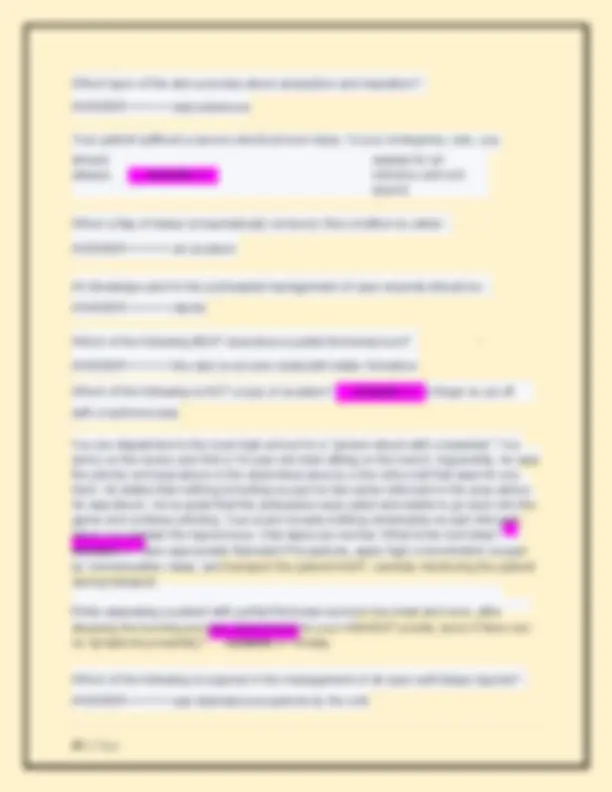



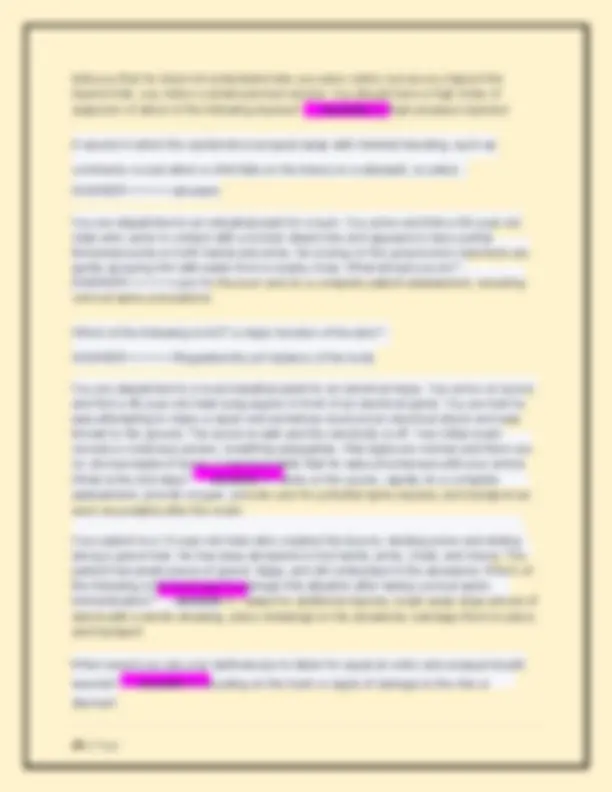




Study with the several resources on Docsity

Earn points by helping other students or get them with a premium plan


Prepare for your exams
Study with the several resources on Docsity

Earn points to download
Earn points by helping other students or get them with a premium plan
Community
Ask the community for help and clear up your study doubts
Discover the best universities in your country according to Docsity users
Free resources
Download our free guides on studying techniques, anxiety management strategies, and thesis advice from Docsity tutors
EMT FINAL EXAM WITH 100+ STRUCTURED QUESTIONS & SOLUTIONS ALL CORRECT RATED & A+ GRADED
Typology: Exams
1 / 27

This page cannot be seen from the preview
Don't miss anything!




















A swelling caused by the collection of blood under the skin or in damaged tissues as a result of an injure d or broke n blood vessel is:
a hematom a. You arrive on scene to a residence where you find a 16-year-old female patient who was shocked while plugging in an appliance in the garage. Her father states that he heard the shock and saw her get "thrown to the ground." The patient is awake and alert still lying on the ground. Based on the patient's presentation, how should you manage this patient's injury? - ANSWER>>> This patient should be fully immobilized. In a contusion, what remains intact? (^) - ANSWER>>> the epidermis In treating open wounds to the neck or abdomen, which type of dressing is preferred? - ANSWER>>>>>>>Occlusive dressing Which of the following is a guideline for the treatment of chemical burns? - ANSWER>>>>>>>wash away the chemical with flowing water To control bleeding, start with: - ANSWER>>> direct pressure and elevation. Burns pose greater risks to infants and children than to adults because: -
ANSWER>>>>>>>their body surface area is greater in relation to their total body size The skin serves which of the following functions? - ANSWER>>> Protection The skin is the largest organ of the body. It is composed of three layers, including the: - ANSWER>>>>>>>epidermis A bruise on the abdomen could indicate injury to which of the following? - ANSWER>>>>>>>Spleen, liver, or kidneys You arrive on scene to an assault. Law enforcement has secured the scene. Your patient is a 23-year-old male with a blood soaked shirt. The patient states that the assailant "slashed at him with a box opener." You expose the chest and note a jagged cut on his left anterior chest with steady, dark red hemorrhaging. Based on this assessment finding, the wound is MOST likely which of the following? - ANSWER>>> Laceration An internal injury with no open pathway from the outside is called: - ANSWER>>>>>>>closed What is the primary risk for electrical injury patients? (^) - ANSWER>>> resp or cardiac arrest Swelling or deformit y at the site of a bruise indicate s a:
possib le underlyi ng fracture The sterile material that is placed directly on a wound is termed the: - ANSWER>>>>>>>dressing
White and dry to dark brown or black and charred skin is a sign of a: - ANSWER>>>>>>>full thickness burn. A way of identifying the seriousness of a burn is by its degree. Which of the following statements is TRUE? - ANSWER>>> A full-thickness burn is also known as a thirddegree burn. What is the FIRST step in removing dry chemicals from the body? - ANSWER>>>>>>>Brush off the excess material. Which of the following statements about electrical burns is TRUE? - ANSWER>>>>>>>all tissues between he entrance and the exit wounds will potentially be injured A patient with an electrical injury is LEAST likely to present with which of the following signs and symptoms? - ANSWER>>> Hypotension A wound under the skin that involves the collection of blood from injury to a large blood vessel is called a: (^) - ANSWER>>> hematoma Possible injury to the cervical spine or brain could be indicated by: - ANSWER>>>>>>>a bruise on the head or neck. The emotional and psychological damage from burn injuries: - ANSWER>>>>>>>begins at the emergency scene. All burns are to be treated as more serious if:
accompani ed by other injuries or
medical problem s. How does the skin provide temperatu re regulation ?
by alterin g the blood flow to the skin and controlling perspirati on A patient has partial thickness burns over 18 percent of his body, including both feet. Which of the following classifications does this patient's burns fall under? - ANSWER>>>>>>>critical Burns involving the airway often lead to: - ANSWER>>> respiratory compromise. Damage to which of the following organs is LEAST likely in the case of abdominal bruising?
- ANSWER>>> Lungs When crushed, the liver and spleen:
bleed profusely and cause shock. In bandaging a hand wound, what important consideration is necessary? - ANSWER>>>>>>>Bandage the hand in the position of function.
For a young child with isolated genital injuries, you should: - ANSWER>>> consider the possibility of abuse and treat the child with sensitivity. In caring for an amputate d part, it is important to:
wra p the part in sterile gauze and keep it cool Which of the following statements about puncture wounds is correct? - ANSWER>>>>>>>Even insignificant-looking puncture wounds can cause devastating injuries. You are called to the scene of a metal fabrication plant where you are presented with a 30 - year-old male patient complaining of bilateral severe eye pain. Upon examination you notice both eyes are red and irritated. Patient states that one of the dyes he was
working with splashed into his eyes. How would you manage this patient's injury? - ANSWER>>>>>>>Irrigate both eyes with copious amounts of water for at least 20 minutes or until you arrive at the medical facility. Generally when providing emergency care of open wounds, the first thing you would do is:
- ANSWER>>> expose the wound Which layer of the skin provides shock absorption and insulation? - ANSWER>>>>>>>subcutaneous Your patient suffered a severe electrical burn injury. In your emergency care, you
should always: (^) - ANSWER>>> assess for an entrance and exit wound When a flap of tissue is traumatically removed, this condition is called: - ANSWER>>>>>>>an avulsion. All dressings used in the prehospital management of open wounds should be: - ANSWER>>>>>>>sterile
Which of the following is NOT a type of avulsion ?
a finge r is cut off with a butcher s saw You are dispatched to the local high school for a "person struck with a baseball." You arrive on the scene and find a 16-year-old male sitting on the bench. Apparently, he was the pitcher and was struck in the abdominal area by a line drive ball that was hit very hard. He states that nothing is hurting except he has some mild pain in the area where he was struck. He is upset that the ambulance was called and wants to go back into the game and continue pitching. Your exam reveals nothing remarkable except mild pain when you palpate the injured area. Vital signs are normal. What is the next step? - ANSWER>>> Take appropriate Standard Precautions, apply high-concentration oxygen by nonrebreather mask, and transport the patient ASAP, carefully monitoring the patient during transport. While assessing a patient with partial thickness burns to his chest and neck, after stopping the burning process, what should be your HIGHEST priority (even if there are no symptoms presently)? - ANSWER>>> Airway Which of the following BEST describes a partial thickness burn? ANSWER>>>>>>>the skin is red and moist with blister formation
Which of the following is MOST likely to be the consequence of a closed crush injury? - ANSWER>>>>>>>internal organs are ruptured Your patient is a 40-year-old man who was burned when he spilled gasoline on his pants as he was standing near the pilot light of his hot water heater. He has partial thickness burns from his feet to just above his knees, and circumferentially around both legs. Using the rule of nines, which of the following MOST accurately represents the extent of body surface area burned? - ANSWER>>> 18% A burn extending into the subcutaneous fat would be classified as which type of burn? - ANSWER>>>>>>>full thickness Which type of wound has a small opening into the skin, but may be quite deep, and is often caused by instruments such as nails, ice picks, or pencils? - ANSWER>>>>>>>puncture A 36-year-old man has accidentally shot a nail into his thigh while using a nail gun. Under which of the following circumstances should the EMT remove the nail from the injury site? - ANSWER>>> The nail should not be removed. While assessing a 78-year-old male patient who escaped an apartment fire with partial thickness burns to both arms, the EMT must be aware of which of the following? - ANSWER>>>>>>>medical conditions may be aggrevated by the burn When managin g an electrica l burn, the EMT should:
ensur e the scene is safe before entering .
Which of the following layers of the skin is the MOST important in insulating the body against heat loss? - ANSWER>>> Subcutaneous layer You are treating the amputation of three fingers on a 40-year-old male. The fingers were torn off while he was cleaning his snow blower. You have stopped the bleeding. What should you do with the amputated fingers? - ANSWER>>> wrap them in a sterile dressing moistened with sterile saline, put them in a plastic bag, and keep them cool Which of the following statements regarding an electrical injury is FALSE? - ANSWER>>> injury is usually limited to the area around the source and ground burns Which of the following is the outermost layer of the skin? - ANSWER>>> epidermis Your patient is a 40-year-old male who has been exposed to a dry chemical powder and is complaining of severe pain on both of his hands, the site of the contact. He is working in an illegal chemical manufacturing plant and there is no decontamination shower on site. Which of the following would be the BEST way to manage this situation? - ANSWER>>> brush away as much of the powder as possible and then have the patient hold his hands under running water from a faucet or regular garden hose When using the rule of palm to estimate the approximate body surface area burned, the patient's palm and fingers equal about what percentage of the body's surface area
thrown to the ground. The scene is safe and the electricity is off. Your initial exam reveals a conscious person, breathing adequately. Vital signs are normal and there are no obvious signs of burns. Coworkers state that he was unconscious until your arrival. What is the next step? - ANSWER>>> while on the scene, rapidly do a complete assessment, provide oxygen, provide care for potential spine injuries, and transport as soon as possible after the exam 9 | Page Your patient is a 14-year-old male who crashed his bicycle, landing prone and sliding along a gravel trail. He has deep abrasions to his hands, arms, chest, and knees. The patient has small pieces of gravel, twigs, and dirt embedded in the abrasions. Which of the following is the best way to manage this situation after taking cervical spine immobilization? - ANSWER>>> asses for additional injuries, brush away large pieces of debris with a sterile dressing, place dressings on the abrasions, bandage them in place, and transport When would you use your stethoscope to listen for equal air entry and unusual breath sounds? - ANSWER>>> bruising on the trunk or signs of damage to the ribs or sternum According to the rule of nines for infants and young children, the patient's head and neck account for what percentage of the total body surface area? - ANSWER>>>>>>>18% Your patient is a 35-year-old female who spilled a cup of hot coffee on herself. She has an area about twice the size of the palm of her hand on her right thigh that is red and painful, but without blisters. When caring for this injury in the prehospital setting, which of the following is appropriate? - ANSWER>>> apply a dry sterile dressing Which of the following statements concerning lacerations is FALSE? - ANSWER>>> then may be degloving injuries to the skin or tissues Bleeding from soft-tissue injuries should initially be controlled with which one of the following techniques? - ANSWER>>> direct pressure
You are caring for a 23-year-old female who fell off a bicycle and sustained a severe laceration on the inside of her upper thigh. Her slacks are torn, and you can see most of the wound. What is the NEXT step? - ANSWER>>> you need to expose the wound completely, clean the surface by simply removing large pieces of foreign matter if any, control bleeding, and dress and bandage the wound Which of the following statements concerning the proper transport of an avulsed ear is FALSE?
- ANSWER>>> it should be wrapped in a dry sterile dressing Your patient is a 25-year-old man who picked up an iron skillet with a very hot handle. He has a reddened area with blisters across the palm of his hand. Which of the following must be avoided in the prehospital management of this wound? - ANSWER>>>>>>>application of antibiotic ointment You are called to an injured person to find a 27-year-old male with a laceration on his anterior forearm. Bleeding is dark red, steady, and fast. You control bleeding with direct pressure and then dress the wound. After you dress the wound, the bleeding restarts. You should: - ANSWER>>> reapply pressure and apply additional dressing material over the top of the original dressing Which of the following statement is TRUE? - ANSWER>>> geriatric patients might not survive burn injuries of an intensity and body area involvement that younger patients would Your patient is a 55-year-old male who was found in the parking lot behind a tavern. He states that he was assaulted and robbed by three individuals. He is complaining of being "hit in the face and kicked and punched in his ribs and stomach." Your examination reveals contusions and swelling around both eyes, bleeding from the nose a laceration of his upper lip, and multiple contusions of the chest, abdomen, and flanks. This patient is showing signs of all of the following possibilities EXCEPT which one? - ANSWER>>>>>>>punctured lung Which of the following is recommended when caring for an amputated part? - ANSWER>>>>>>>Seal the part in a plastic bag kept cool with cold packs.
Laceration What is the primary risk for electric al injury patients ?
res p or cardiac arrest Swelling or deformity at the site of a bruise indicates a: - ANSWER>>> possible underlying fracture The sterile material that is placed directly on a wound is termed the: - ANSWER>>>>>>>dressing What is an example of classifying a burn by agent and source? - ANSWER>>>>>>>thermal burn from excessively hot coffee Your patient has sustained a chemical burn to her hands from dry lime. How is this treated in the field? - ANSWER>>> Brush off the powder before using water to flush. A burn injury should be considered to be: - ANSWER>>> an injury with the potential for many far-reaching effects. You are dispatched to the scene of a construction site where a 33-year-old male has been impaled with a piece of rebar to his right anterior chest near the clavicle. The rebar is too long to allow transport of the patient. The patient is alert and seated on the ground. How should you manage this injury? - ANSWER>>> Contact medical control and ensure someone stabilizes the object while it is gently cut to the desired length. When assessing a patient, consider the possibility of closed soft-tissue injuries An internal injury with no open pathway from the outside is called: - ANSWER>>>>>>>closed
whenever there is swelling, pain, or deformity, as well as
a mechanis m of blunt trauma In treating a puncture wound of the eye, if you bandage both eyes, it is because: - ANSWER>>>>>>>you want to avoid sympathetic eye movement. Your patient has burns to the entire right arm and the anterior chest. What is the estimated surface area involved? - ANSWER>>> 18 percent A patient has partial-thickness burns over 35 percent of her body, including both feet. Which of the following classifications does this patient's burns fall under? - ANSWER>>>>>>>Critical You are assessing a patient and notice red discoloration with blisters on the legs. This type of burn would be classified as: - ANSWER>>> partial thickness. White and dry to dark brown or black and charred skin is a sign of a: - ANSWER>>>>>>>full thickness burn. A way of identifying the seriousness of a burn is by its degree. Which of the following statements is TRUE? - ANSWER>>> A full-thickness burn is also known as a thirddegree burn. What is the FIRST step in removing dry chemicals from the body? - ANSWER>>>>>>>Brush off the excess material. Which of the following statements about electrical burns is TRUE? - ANSWER>>>>>>>all tissues between he entrance and the exit wounds will potentially be injured
When crushed, the liver and spleen:
bleed profusely and cause shock. In bandaging a hand wound, what important consideration is necessary? - ANSWER>>>>>>>Bandage the hand in the position of function. You are caring for a 15-year-old female who has sustained a laceration to her lower arm. It is spurting bright red blood uncontrollably. What personal protective equipment would be MOST preferred in managing this wound? - ANSWER>>> Gloves and a face shield You are performing a secondary assessment on your 19-year-old trauma patient with a severely bruised trunk and signs of damage to the ribs and sternum. He is coughing up frothy red blood and having difficulty breathing. What injury do these signs point to? - ANSWER>>>>>>>a punctured lung Your patient has a large bump on the forehead from being hit by a baseball. What type of injury is this? - ANSWER>>> hematoma Part of the assessment of a thermal burn is to calculate the percentage of the body surface area that has been burned. Your patient has burns to her anterior torso (chest and abdomen) and the anterior surface of her right arm. What is the estimated percentage of body surface burned? - ANSWER>>> 22.5 percent The layer of skin that is rich with blood vessels, nerves, and specialized structures is the:
- ANSWER>>> dermis You are caring for a 46-year-old female who accidentally sustained burns to her left hand up to the wrist from boiling water. You arrive moments after the incident. Of the following, which should you do FIRST? - ANSWER>>> cool the bburned area to stop the burning process
A patient who was injured by lightning is awake on your arrival but is not able to hear what you are saying. He can talk and is frightened because he does not know what happened. The patient was in a picnic area at a park and was thrown several feet to the ground when the lightning struck near him. Which of the following steps has the HIGHEST priority in this patient's assessment and treatment? - ANSWER>>> Fully immobilize the patient. For a young child with isolated genital injuries, you should: - ANSWER>>> consider the possibility of abuse and treat the child with sensitivity. In caring for an amputate d part, it is important to:
wra p the part in sterile gauze and keep it cool Which of the following statements about puncture wounds is correct? - ANSWER>>>>>>>Even insignificant-looking puncture wounds can cause devastating injuries. You are called to the scene of a metal fabrication plant where you are presented with a 30 - year-old male patient complaining of bilateral severe eye pain. Upon examination you notice both eyes are red and irritated. Patient states that one of the dyes he was
working with splashed into his eyes. How would you manage this patient's injury? ANSWER>>>>>>>Irrigate both eyes with copious amounts of water for at least 20 minutes or until you arrive at the medical facility. Generally when providing emergency care of open wounds, the first thing you would do is:
- ANSWER>>> expose the wound